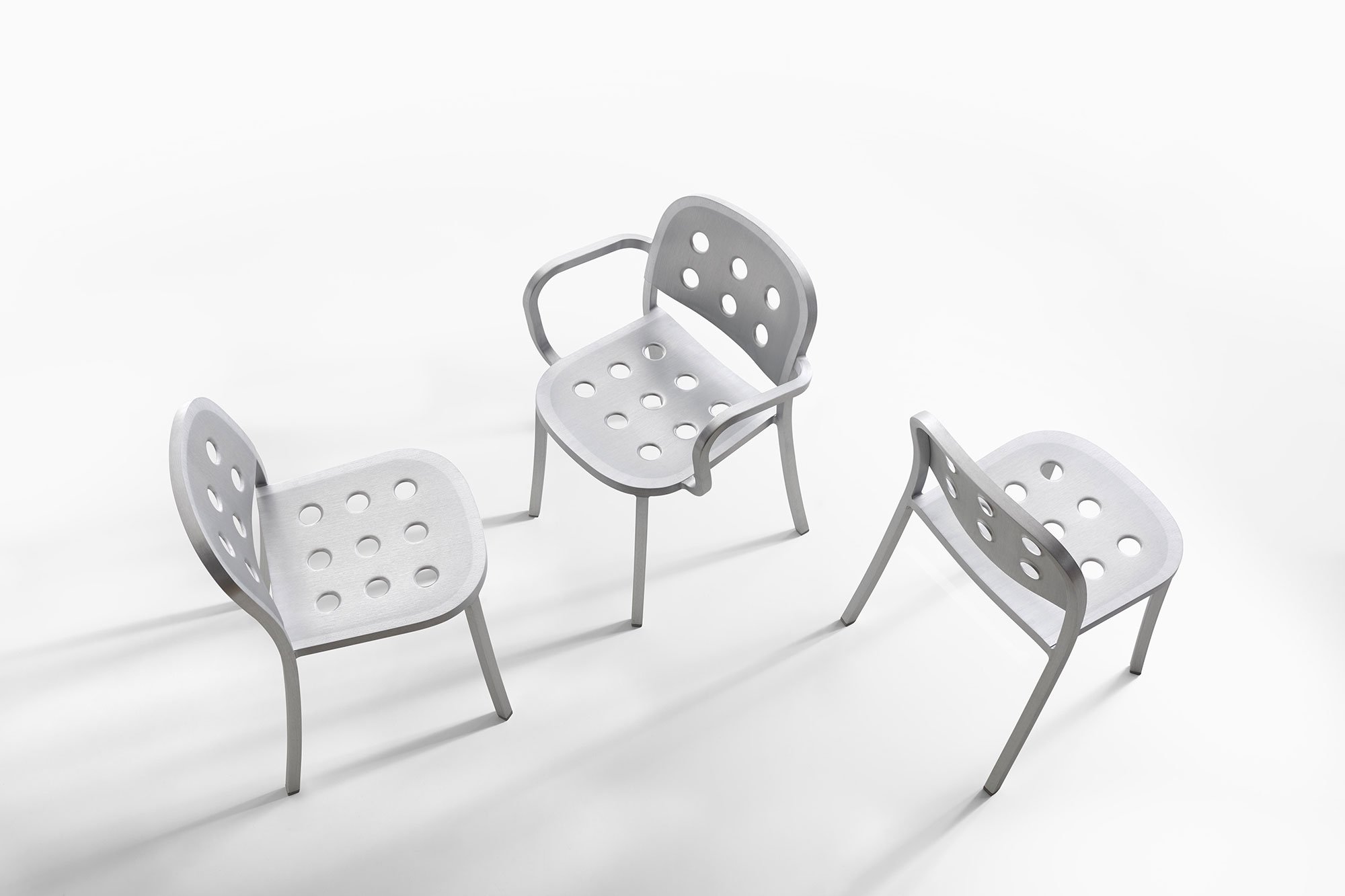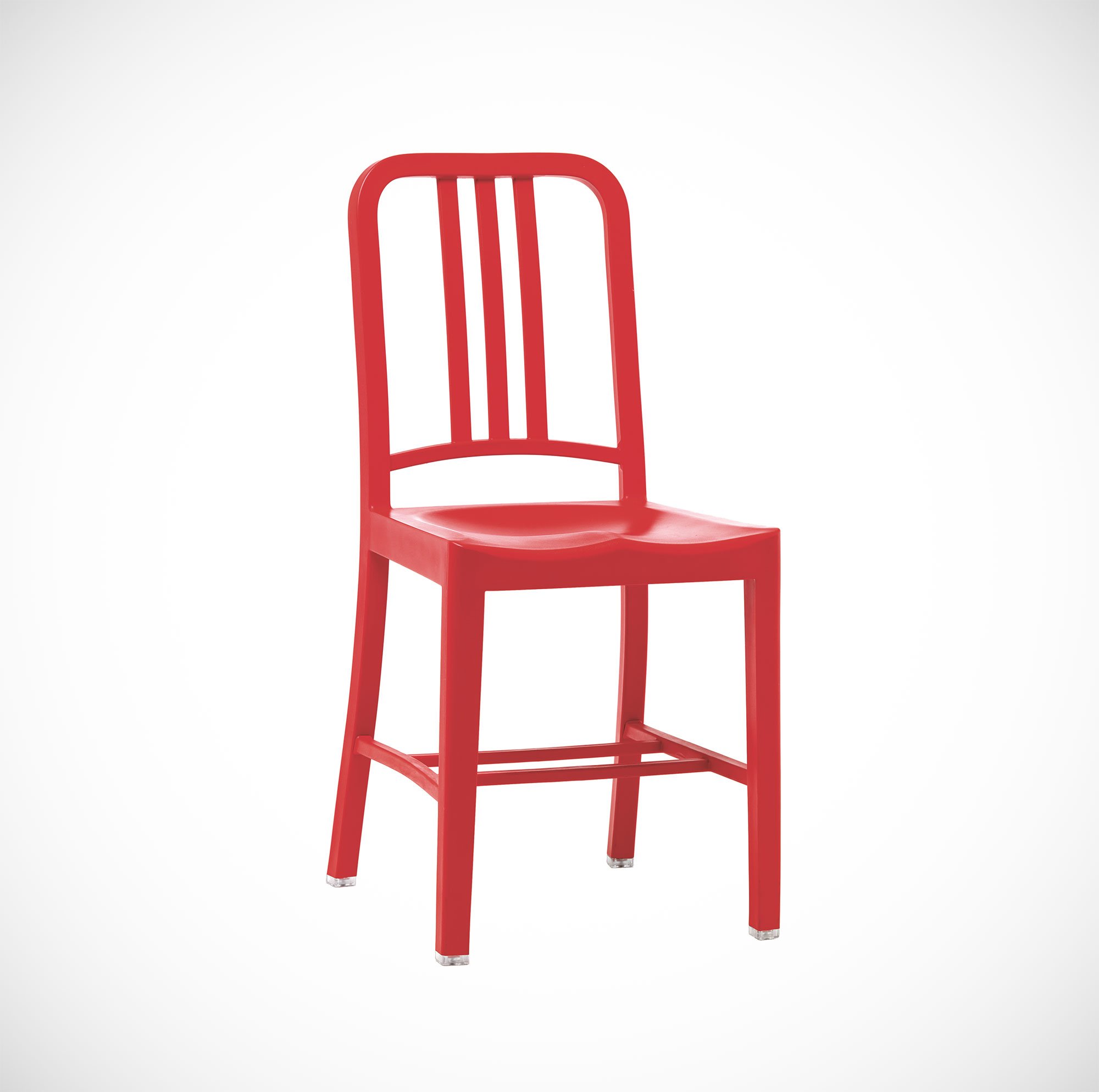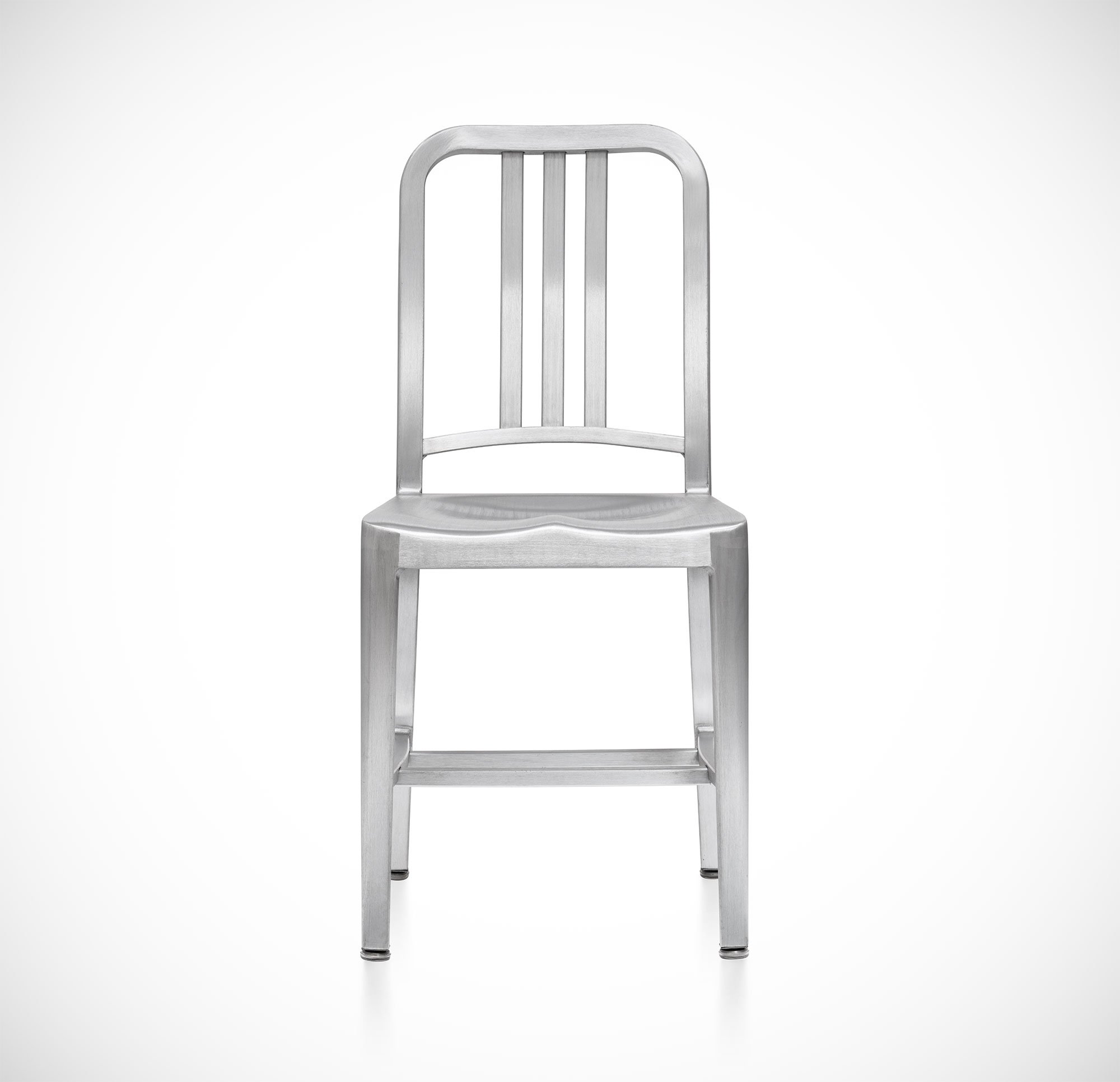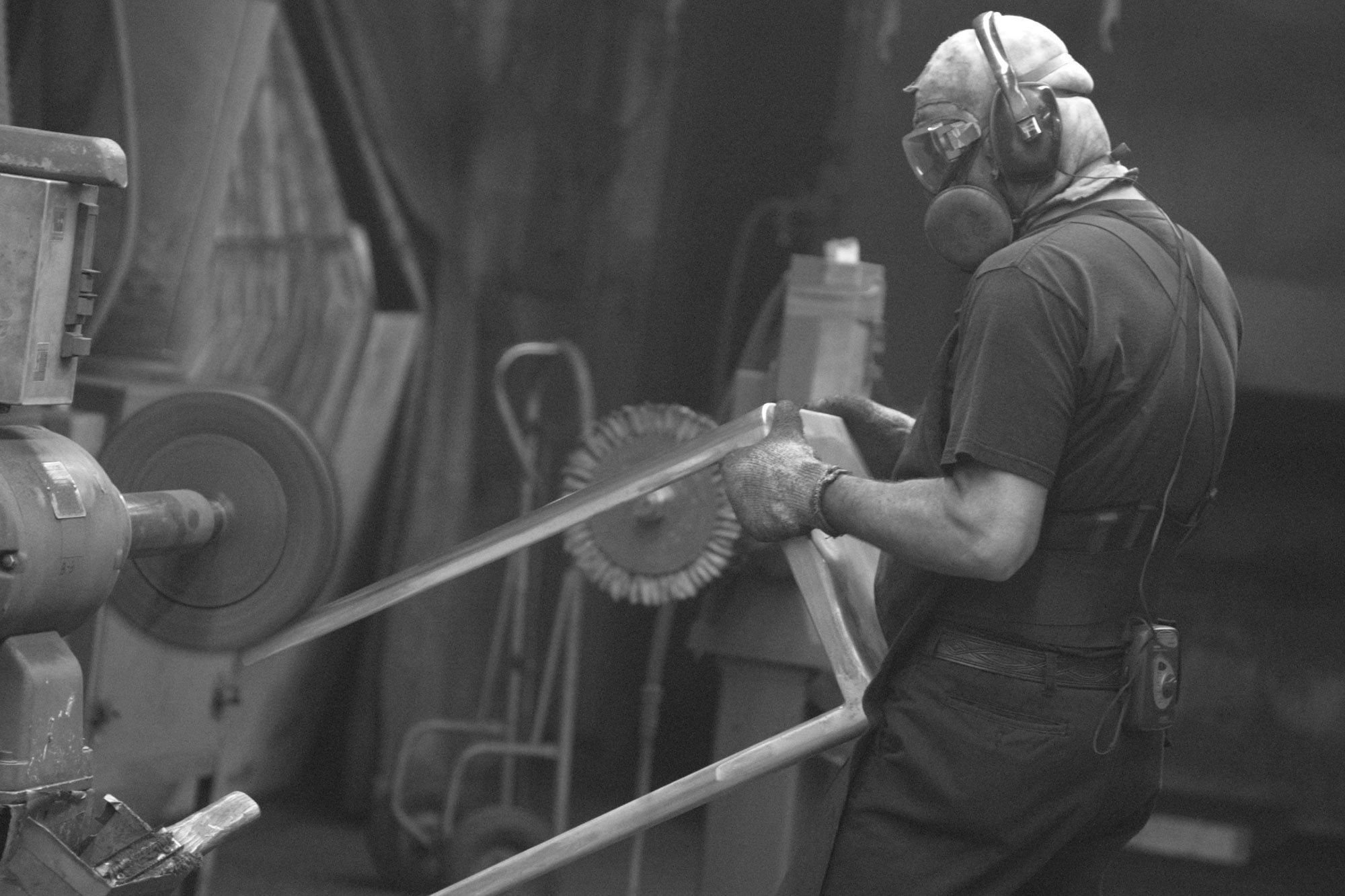The year was 1944 and the U.S. Navy needed a chair. On the face of it, a rather simple requirement. However, the navy had a number of quite specific requests: the chair should be lightweight and fireproof, able to withstand the corrosive effects of salt air and water, sporadic torpedo blasts, and perhaps most importantly, it should be durable—holding its own against the navy’s beefy, burly sailors. The U.S. Navy worked with Emeco to realize its vision (Emeco—the Electrical Machine and Equipment Company—was set up in 1944 by Wilton Carlyle Dinges), and the 1006 Navy Chair was born. Made by hand at Emeco’s factory in Hanover, Pennsylvania, using a 77 step process and recycled aluminum (aluminum), the Navy Chair was built to last. Today, this one-time wholly utilitarian chair is a much lionised icon of good design.
More Behind the Design
There was a period of time when Emeco’s fate as a company appeared to be sealed. With the end of the Cold War, the U.S. Navy’s orders for the Navy Chair came to a halt. The factory was on the verge of collapse, in part because the Navy Chair was made so well (a chair built to last did not need to be replaced). When Gregg Buchbinder (Emeco’s CEO) came to the company, he found a factory in a state of disrepair and a skeleton crew of downhearted craftsmen, awaiting the day when the factory would close. But he also discovered that Emeco had received orders for its Navy Chair from certain big name designers, including Terence Conran and Philippe Starck. With this, Gregg realised the utilitarian aluminum Navy Chair had a future: one that was design-led. This beautiful, hand-made object was ideal for use in restaurants, offices, hotels and people’s own homes.
These days, under Gregg Buchbinder’s insightful leadership, Emeco is a prosperous business. Its extraordinary design roster includes Jasper Morrison, Nendo, Konstantin Grcic, Ettore Sottsass and Philippe Starck. More importantly, Emeco’s values are an integral part of every endeavour: the company is sincere and transparent, and works hard to ensure its products are thoughtful, useful, aesthetic and people-centred. Sustainability is at its core—recycled aluminum, recycled PET (rPET), reclaimed wood polypropylene, natural wood (previously used or responsibly sourced), eco-concrete and cork, are Emeco’s materials of choice. Underpinning all of this: Emeco is ‘Made in America’ and a shining example of that nation’s design prowess.
Gessato gets behind the design with Gregg Buchbinder.
What drew you to Emeco?
Back in 1998, I had the opportunity to tour the Emeco factory in Hanover, Pennsylvania. As I was touring the factory, rain was leaking in from the roof and there was a skeleton crew of dispirited craftsmen who had remained to operate the plant, waiting for word on its closure. In spite of that, I also saw something else—I saw good bones. It’s like when you walk through a dilapidated house, but you know you can make it into something beautiful because it has good bones; it’s what I saw in the Emeco factory. There was heart and history, and everything I had grown up with—that sense of design, of rock solid engineering, a commitment to sustainability and to made in America. I saw it all in one Emeco chair: the 1006 Navy Chair.
I believed in the values of the Navy Chair, a chair made of recycled aluminum, using a 77 step process. It was non-corrosive, fireproof, lightweight and guaranteed to last 150 years.
I love the story of Paulina and Giorgio Armani, and the fact that unbeknown to you, some great designers were using Emeco.
Yes. When I was touring the Emeco factory, in the front office I heard Paulina say: ‘you send us the money and we’ll send you the chairs.’ She slammed down the phone and I asked her who it was? ‘Giorgio Armani,’ she replied. Under the radar, important design leaders had discovered Emeco and were using the company in their projects. They included: Ettore Sottsass (a frequent collaborator with Esprit), Terence Conran, Philippe Starck (commissioned to redesign areas of the Paramount Hotel in New York), and Frank Gehry (designing for N .Y. Bagel Co.). These top designers saw the same thing I saw in the Navy Chair—craftsmanship, simplicity and heritage. This company was too important to die. I acquired Emeco and began my journey to discover a new market, in order to survive.
When I listened to you speak during a talk1 at this year’s London Design Festival, your passion for sustainability in design was palpable. Where does that passion come from?
I grew up in Huntington Beach, California. I surfed every day before school, after school, and sometimes during school. Being in the ocean every day gives you a real appreciation of, and connection to, the environment—the sun, clean salt water, birds, fish and dolphins. My mom was an interior designer and would leave design magazines lying around the house, which I enjoyed looking at. My father was an engineer and worked on the steel understructures of chairs for companies such as Herman Miller. They would give him the rejects that had been made for display at trade shows. Our mid-century modern home was filled with Eames trade show rejects—now called prototypes. It was an amazing environment to grow up in. My life revolved around design, engineering, a love for the ocean and a concern for the environment.
During the same talk, there was a discussion around the belief that objects need to delight humans—they should be humanistic. Can you expand on this from Emeco’s perspective.
I think keeping the planet alive is pretty humanistic!
To give you an example, in 2010, Coca-Cola had a lot of discarded plastic bottles. The PET plastic bottle is the most cost-effective way to deliver their beverages, yet many millions of these bottles are filling up our landfills. Coca-Cola approached Emeco with a proposition: ‘Let’s make something people won’t throw away.’ It took new science and a lot of hard work to invent a way to upcycle rPET. We created the 111 Navy Chair, a piece made out of at least 111 plastic bottles. And baked into every 111 chair is sustainability, timeless design and the heritage of Emeco.
The 111 Navy Chair succeeds in ways well beyond recycling. To date we have kept over 30 million bottles out of landfill, and inspired dozens of companies such as Adidas, Levi’s and Timberland, to join our cause. And we have motivated the average citizen to be more responsible about waste.
What is the design process behind a new chair? I assume it’s quite an investment?
The design process for developing a new Emeco chair can mean an investment over several years. I start with a relationship with a designer, getting to know them and learning what their design for a chair might be. The process continues as we invest in tooling for the chair, numerous prototypes, the selection and use of design elements—for example reclaimed, repurposed, recycled materials, color palettes, wood and finishes. At the final stage, we have the product launch. I choose to work with proven designers to guarantee that my investment results in a great chair that people will want.
One might argue the case that in the Navy Chair, Emeco had made the perfect seat: durable, sustainable, aesthetic, useful and long-lasting. Why then go on to make a whole series of other chairs?
The 1006 Navy Chair was selling well, but it wasn’t enough to keep our large factory open. I met Philippe Starck at a trade show and he offered to design a new chair: the Hudson Chair (launched in 2000). I realized that new designs by well-known designers would be appreciated by consumers, thereby adding to Emeco’s work portfolio and enabling us to keep the company going.
Today, the Navy Chair can be found in locations around the world. What makes it so successful and indeed covetable?
The Navy Chair is found in locations around the world because it lasts forever. Each and every Emeco Navy Chair is still in use today. This simple, humble, timeless, classic design, this utilitarian chair, has become iconic.
Emeco and the Navy Chair will celebrate their 75th birthday in 2019. That’s an impressive milestone for a chair in continuous production since 1944. How will Emeco mark the occasion?
We have not made plans yet for our 75th birthday. Maybe a small dinner for the people who have helped keep Emeco alive, remembering our purpose and celebrating what we have accomplished together. And thinking about how to make chairs out of the great Pacific garbage patch.
At Emeco, you work with a range of materials, a number of which are technically innovative. Do you have a particular favourite—a material that you find especially appealing and intriguing? Allied to this, do you have a favourite Emeco chair design?
I am so grateful to Philippe Starck for the Hudson Chair. That design and his involvement with Emeco inspired a turnaround, redefining what was essentially an industrial brand as a designer brand. I am also very proud of the determination we had when spending four years on the development of the 111 Navy Chair using rPET—that was a huge investment of time and collaboration. And I love the velvet feel and color palette of our new 1 Inch Reclaimed Chair by Jasper Morrison. It’s made from reclaimed wood polypropylene.
Nowadays, we might be forgiven for thinking the USA (along with many other countries), outsources the vast majority of its manufacturing work to China. Emeco is a perfect example of great design made well in America. Why is it important that you remain firmly rooted in Hanover, Pennsylvania?
Our factory in Hanover, Pennsylvania, has been there since 1944—it’s the place where Emeco’s story began. It houses all the equipment and processes, and many of the same employees that have been making Emeco chairs for years. Those resources are very valuable to us and allow us to continue to make our chairs in the USA.
1During London Design Festival 2018, Gregg spoke at ‘Re: Use’—a discussion about the usage and reuse of materials, along with designer Michael Marriott. The talk was hosted by Disegno magazine at SCP.










